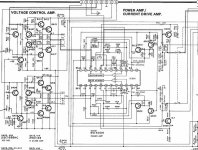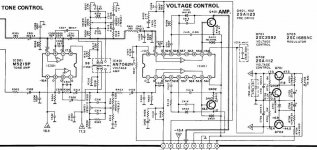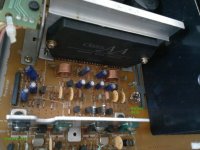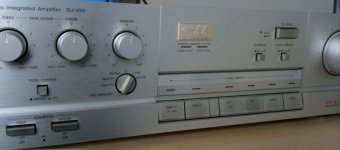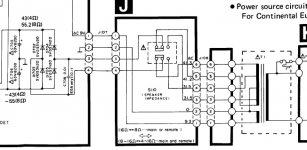... or should I use its parts for example Krill🙄
I bought it failured, but visual mint😀
for now R436, 438 and T411 are burned,
I do not know if other parts are OK😕
Does anybody hear this amp and recommend its sound?
Please indicate what might be the purpose of burned parts?
I bought it failured, but visual mint😀
for now R436, 438 and T411 are burned,
I do not know if other parts are OK😕
Does anybody hear this amp and recommend its sound?

Please indicate what might be the purpose of burned parts?
Last edited:
for now R436, 438 and T411 are burned
sorry for inconvenience
R439 and Q415 are burned, this time R435 survived...
Attachments
Last edited:
It's probably not worth repairing. The module with "class AA" written on it would cost much more than the amplifier is worth. That's if it's even available.
I could be wrong on this but I was given a Technics amp for spares about 12 years ago and I thought about repairing it.... then I got a quote of about £72 for the module!! It was only a low model in the range as well, about 30WPC.
I could be wrong on this but I was given a Technics amp for spares about 12 years ago and I thought about repairing it.... then I got a quote of about £72 for the module!! It was only a low model in the range as well, about 30WPC.
It certainly looks like it is worth saving. 😀
But then again, if that great big module is gone... 🙁
But then again, if that great big module is gone... 🙁
It certainly looks like it is worth saving. 😀
But then again, if that great big module is gone... 🙁
:-/
it would be hard to mount discrete transistors to the radiator
which is set for the power module...

Hi
(if anyone interested...?)
I found that AN7062 is broken
I ordered new one
and will inform if works after soldering.
(if anyone interested...?)
I found that AN7062 is broken
I ordered new one
and will inform if works after soldering.

R436 burned with fireworks!

😱
I am starting to thinking what amplifier to build inside V50...😕
The important thing is a power transformer, has lower and higher voltage taps - the preamp/voltage section might be powered with higher voltage, power section with lower...
Attachments
Are the transistors in the voltage amp section ok? As r436 will blow if there is a fault in that area.
What voltage is at the emitter resistors there ?
What voltage is at the emitter resistors there ?
Are the transistors in the voltage amp section ok? As r436 will blow if there is a fault in that area.
What voltage is at the emitter resistors there ?
Blowed: R436, R438, Q407, Q415,
I cannot measure the emmiter voltages now, the amp is packed and is waiting for a better times...😉
Hi Pawel
I have a working SUV50 series KXL but it is not constructed like yours. This one has similar thermal-wick heatsinking but the modules are small, just the output stage in a diecast shell, I think. It seems that the whole amp is in your big hybrid modules, just like many amplifiers of the period.
The sad part is that the sound of the super AA and AAA+ Technics amps was generally very good for the price. The quality is half way to class A indeed and it goes very loud for little heat at all. It's a great pity that it won't be an economical repair.
I would make one comment about the amplifier (and mine is rated 70W/channel/8 ohms). The transformer looks undersize for the job and would have to "duck" under load, since the rails are 58V. Lower rails are manually switched for 4 Ohm loads and this must have been a problem for unaware users.
Personally, I would not try to keep any parts of the power supply. It's clearly not rated for continuous RMS power output at the rating.
I have a working SUV50 series KXL but it is not constructed like yours. This one has similar thermal-wick heatsinking but the modules are small, just the output stage in a diecast shell, I think. It seems that the whole amp is in your big hybrid modules, just like many amplifiers of the period.
The sad part is that the sound of the super AA and AAA+ Technics amps was generally very good for the price. The quality is half way to class A indeed and it goes very loud for little heat at all. It's a great pity that it won't be an economical repair.
I would make one comment about the amplifier (and mine is rated 70W/channel/8 ohms). The transformer looks undersize for the job and would have to "duck" under load, since the rails are 58V. Lower rails are manually switched for 4 Ohm loads and this must have been a problem for unaware users.
Personally, I would not try to keep any parts of the power supply. It's clearly not rated for continuous RMS power output at the rating.
The psu parts are still good for a stereo amplifier of maybe half the power of the original.
I never throw away the transformer when i take apart a broken amp, just because transformers are expensive.
I never throw away the transformer when i take apart a broken amp, just because transformers are expensive.
Tekko, I can't guarantee the same parts are involved but the transformer I refer to is an E-I type of no more than 140 VA, unframed and bolted through the chassis, like old valve types. It runs hot without load, is relatively noisy and does not inspire confidence.
Sure, you can make an amplifier with any junk at all if you are not too fussy about extra noise, heat and really awkward mounting. I confidently advise that the best use for this one is a (small) boat anchor!
The electrolytics are at end of life so that leaves only a cheap, small bridge or four even cheaper diodes. What is the point saving this for audio that we take such pains designing for Hi-Fi but build it using something much less?
Sure, you can make an amplifier with any junk at all if you are not too fussy about extra noise, heat and really awkward mounting. I confidently advise that the best use for this one is a (small) boat anchor!
The electrolytics are at end of life so that leaves only a cheap, small bridge or four even cheaper diodes. What is the point saving this for audio that we take such pains designing for Hi-Fi but build it using something much less?
thats rather common, i have a transformer that originally was strapped to a baseplate with a metal strip thats rated to 400VA but looks more like a 100-200VA size, the amp it came from was rated 50-75 watts per channel.
I have another transformer from a home cinema receiver thats rated 425VA and its atleast twice the size.
However if the transformer is so small its obviously 80VA or less, i wouldent bother to use it for a poweramp, but i still keep them as their good for smaller stuff like headphone amps or preamps or why not a small regulated lab psu.
I have another transformer from a home cinema receiver thats rated 425VA and its atleast twice the size.
However if the transformer is so small its obviously 80VA or less, i wouldent bother to use it for a poweramp, but i still keep them as their good for smaller stuff like headphone amps or preamps or why not a small regulated lab psu.
Those Technics amps typically had about the same output power at 4 and 8 ohms, so the xfmr wouldn't be expected to be supersized. The sagging supply rails tend to keep the output stage transistors in their SOA and hence reliability up.
Repairing one of these units requires careful thought, patience and diligence - as with any complex DC-coupled amplifier, except that ICs don't exactly make things easier. Swapping out the obviously defective parts definitely will not do.
So Q407 and Q415 are dead... looks like this channel is latching up hard. Every single part in it should be checked. A lightbulb current limiter or variac in the power line is a good idea for power amp repairs in general.
If that big SVI hybrid should be dead, well... bad luck. I wouldn't just assume it though.
Repairing one of these units requires careful thought, patience and diligence - as with any complex DC-coupled amplifier, except that ICs don't exactly make things easier. Swapping out the obviously defective parts definitely will not do.
So Q407 and Q415 are dead... looks like this channel is latching up hard. Every single part in it should be checked. A lightbulb current limiter or variac in the power line is a good idea for power amp repairs in general.
If that big SVI hybrid should be dead, well... bad luck. I wouldn't just assume it though.
Last edited:
They are very good amps when they work I have a 70Wpc version . However if it's anything like mine the feedback structure is quite complex and this means that if any one part fails it's hard to diagnose. You should be able to tap off the audio signals before the power amp, strip the existing power amp and fit a new power amp. That way you keep all the existing controls working and have a working amp.
- Status
- Not open for further replies.
- Home
- Amplifiers
- Solid State
- is Technics SU-V50 worth repairing...
